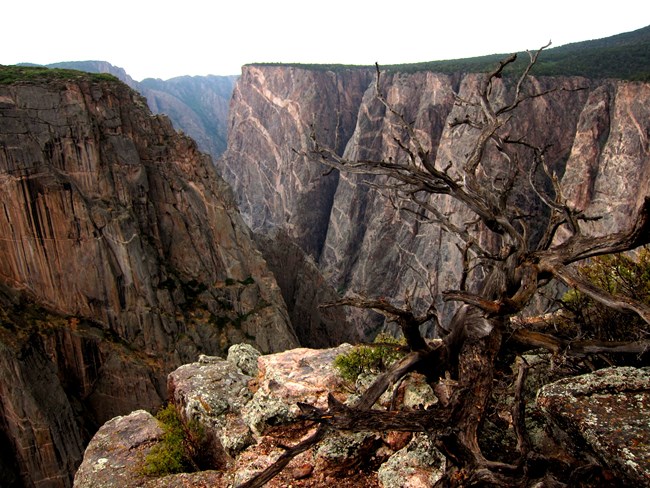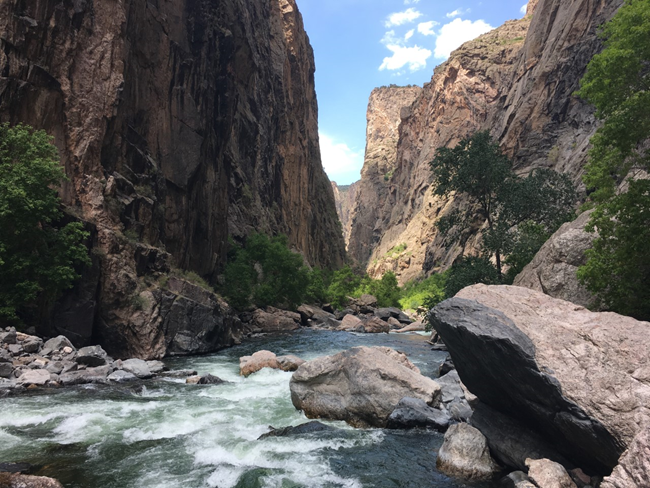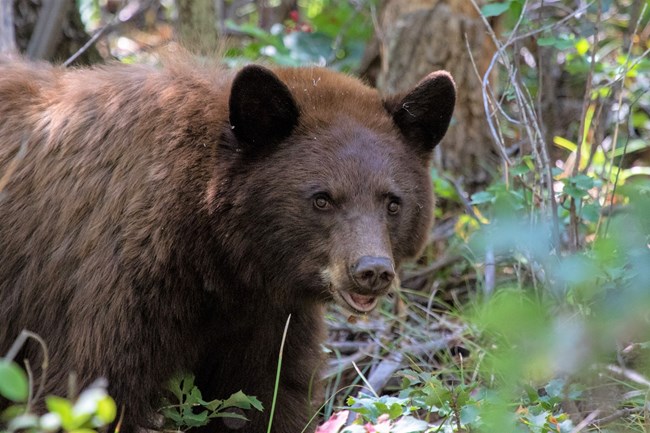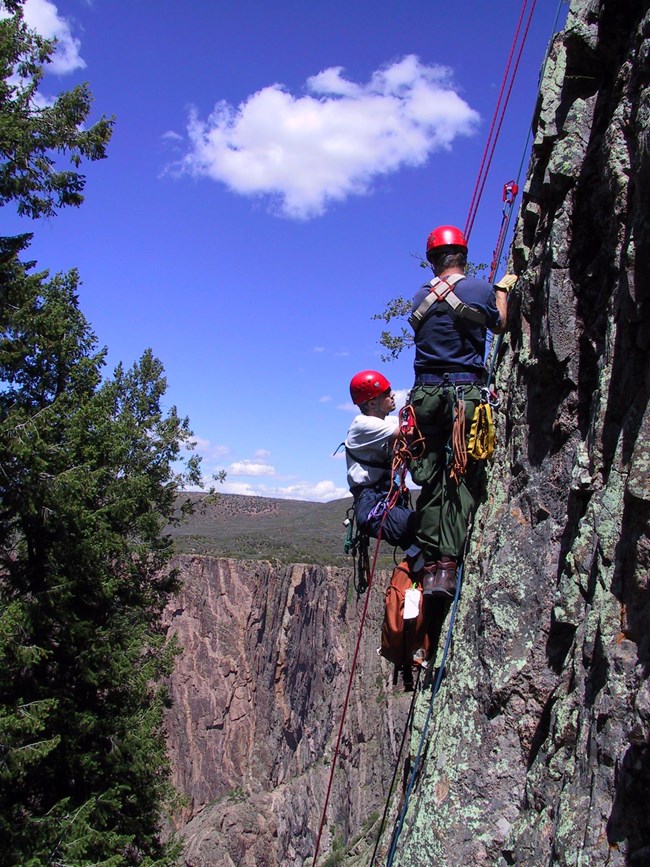The following information is summarized from the Northern Colorado Plateau Network monitoring plan, published in 2004. Some details may have changed.
Park History and Purpose

NPS/A. Washuta
President Herbert H. Hoover established Black Canyon of the Gunnison National Monument on March 2, 1933 (Presidential Proclamation No. 2033), under provisions of the Antiquities Act (34 Stat. 225; June 8, 1906), for the purpose of “…preservation of the spectacular gorges and additional features of scenic, scientific, and educational interest...”.
Lands were added to the monument in 1935, 1938, 1939, 1958, and 1984. Public Law 98-357, which authorized the 1984 park additions, states, "The purpose of this Act is to establish a boundary for the Monument in order to promote, perpetuate, and preserve the character of the land and to preserve scenic and historic resources." The Act’s language recognized Black Canyon as possessing "outstanding recreational opportunities and natural characteristics of high value which … contribute as an enduring resource.… " The background Congressional Record information provided with the boundary-expansion legislation states, “Although the monument contains a multitude of scientific, educational, cultural, historical, and other benefits, the center of attraction to the area is, without a doubt, the viewshed.” In 1976, Public Law 94-567 designated 4,525 hectares (11,180 acres) of the monument as wilderness, pursuant to the Wilderness Act of 1964. Through enactment of P.L. 106-76 in October 1999, additional lands, including 1,790 hectares (4,423 acres) of wilderness, were added and the monument was designated Black Canyon of the Gunnison National Park. The 1999 act states, “the Black Canyon of the Gunnison and adjacent upland include a variety of unique ecological, geological, scenic, historical, and wildlife components, … extensive opportunities for educational and recreational activities, … unique geological, paleontological, scientific, educational, and recreational resources; … some private land adjacent to the Black Canyon of the Gunnison National Monument has exceptional natural and scenic value that would be threatened by future development pressures…”
Location
Black Canyon of the Gunnison National Park is located in Colorado’s Montrose County. The park is located approximately 402 kilometers (250 miles) southwest of Denver, Colorado, and 24 kilometers (15 miles) east of Montrose, Colorado.
Elevation
Elevations vary from 1,645 meters (5,400 feet) at canyon bottom to 2,675 meters (8,775 feet) on Signal Hill.
Size
12,159 hectares (30,045 acres)

NPS
General Description
The Black Canyon is a textbook example of a superimposed stream. Canyon walls rise precipitously 610 meters (2,000 feet) or more above the Gunnison River, which roars in the canyon depths at an average gradient of 29 meters (95 feet) per mile in the park.
The Black Canyon is one of the world's foremost wild canyons. About 1.3 to 1.7 billion years ago, canyon rocks (gneiss, schist, quartz-monzonite, and granite-pegmatite) were formed far below Earth’s surface. Around 60 million years ago, during the forming of the Rocky Mountains, these hard, crystalline rocks were uplifted to near Earth’s surface in the Gunnison uplift. From 35 to 18 million years ago, volcanic action from the West Elk and San Juan Mountains covered the area with ash, tuff, and breccia. Erosion slowly wore away these volcanic layers, along with the underlying sedimentary rocks, and established the course of the Gunnison River. Two million years ago, the river started cutting into igneous and metamorphic rocks and the Black Canyon of the Gunnison was formed.
Some of the park’s biotic communities are representative of communities found in a broad geographical region. Others are unique to Black Canyon. The canyon rims are dominated by scrub oak and pinyon-juniper forests, intermixed with patches of high desert sagebrush communities. Two sizable pinyon-juniper groves exist; one on each rim at about 2,438 meters (8,000 feet). Within these groves are many large pinyons, some over 700 years old. The canyon’s north-facing slopes favor Douglas-fir and Colorado blue spruce. The river bottom has a number of deciduous trees and shrubs characteristic of river strands in the region. Very few ponderosa pines are found along the river bottom, where they were protected from past annual high spring flows. A small amount of riparian vegetation, as well as scattered stands of ponderosa pine, Utah juniper, and box elder, also occur along the river.
Locally, the dominant shrub species is the Gambel oak, with serviceberry ranking second, and lesser amounts of mountain mahogany. Sagebrush is found in areas of good soil, and rabbitbrush is occasionally found. Another park ecosystem is the pinyon-juniper woodland.
The associated vegetational ecosystems provide habitat for wildlife—including, but not limited to, river otter, mule deer, bighorn sheep, black bear, bobcat, mountain lion, elk, golden eagle, peregrine falcon, and a variety of seasonal raptors. Small mammals include porcupines, weasels, and golden-mantled ground squirrels. The canyon rim is especially important habitat for birds because of air currents and unique interactions of rock, soil, topography, and surrounding plant communities that meet at the rim to create a distinct ecotone.
Temperatures range from a low of -9°C (15°F) in the winter to approximately 29°C (85°F) in the summer. Average annual precipitation is 400-508 millimeters (16–20 inches) and snowfall measures between 76 and 140 centimeters (30 and 55 inches). Most precipitation occurs in the form of spring and summer rains. The wind is predominantly out of the southwest, with episodes of high velocity (64–97 kph/40–60 mph). Canyon bottoms are typically 5–8°C (10–15°F) warmer than rimtops during the summer months.

NPS/J. Stringfield
Unique Features and Species of Special Concern
Visitors may encounter a wide range of native and nonnative plant and animal species throughout the site.
Black Canyon of the Gunnison National Park offers a unique and spectacular landscape. No other North American canyon combines its narrow opening, sheer walls, and startling depths. A number of unique ecological niches harbor species not found in abundance or absent on surrounding lands because of topographic variation, soil development, and exposure to sun and wind.
Plants and Vegetation Communities
At least four rare plants are either known or suspected, including Black Canyon gilia (Gilia pentstemonoides), hanging garden sullivantia (Sullivantia hapemanii var. purpusii), Uinta Basin hookless cactus (Sclerocactus glaucus), and backward-facing beardtongue (Penstemon retrorsus). Unique geological conditions and semi-arid environments combine to create a number of habitats of particular interest, including seeps, springs, riparian areas, and hanging gardens.
Animals
The park’s geographic location and natural resources make it attractive for a number of sensitive and rare wildlife species. The topography has attracted a significant raptor population, including golden eagles, bald eagles, prairie falcons, peregrine falcons, and many migrating birds of prey. It is suspected that the southwestern willow flycatcher uses riparian features. Peregrine falcons nest on the cliffs. The Gunnison sage-grouse, a recently recognized species, uses the sagebrush habitats on the north boundary to meet its year-round habitat needs.
The wildlife is typical for the regional geography and elevations. Large mammals include mule deer, black bear, bobcat, elk, and an occasional mountain lion. Rocky Mountain bighorn sheep were reintroduced on Bureau of Land Management lands west of the park in 1985. Individuals, possibly from this transplant or from historic herds, are observed in the park, although no increase in sheep numbers has been detected. River otters were reintroduced at the east (upstream) boundary and are occasionally seen along the river in the park.
The upstream water impoundments have dramatically altered the historic fish population and composition. The native species of Colorado River cutthroat trout, Colorado roundtail chub, bonytail chub, bluehead sucker, flannelmouth sucker, and other native species may be displaced by non-native rainbow and brown trout. The present excellent conditions for brown and rainbow trout have led to the Colorado "Gold Medal Waters" fishery designation for the Gunnison River through the park and lower gorge.
Resource Management Concerns
Major natural resource issues at the park include:
Livestock Grazing
Livestock production and irrigated farming have been a way of life since the mid-nineteenth century. The principal use of the land surrounding Black Canyon of the Gunnison National Park is livestock grazing. Recurring problems are developing between grazing and wildlife habitat associated with timing of seasonal grazing use, stocking levels, and inadequate fencing. Lack of fencing has resulted in livestock trampling of riparian vegetation and soil compaction. Livestock grazing may be affecting habitat for Gunnison sage-grouse, elk, mule deer, and bighorn sheep.
Exotic Plants and Animals
Exotic plant species are invading both disturbed and undisturbed areas throughout Black Canyon, displacing native species. Exotic vascular plants of particular concern include cheatgrass (Bromus tectorum), Canada thistle (Cirsium arvense), bull thistle (Cirsium vulgare), musk thistle (Carduus nutans), Russian knapweed (Centaurea repens), spotted knapweed (Centaurea stoebe), hoary cress (Lepidium draba), common mullein (Verbascum thapsus), houndstongue (Cynoglossum officinale), and tamarisk (Tamarix ramosissima).

NPS
While the upstream water impoundments have increased the valuable fishing resource through the park from a sport fishery standpoint, it has also impacted native species. Native fish species of particular concern are the Colorado River cutthroat trout (Oncorhynchus clarki pleuriticus), Colorado roundtail chub (Gila robusta), flannelmouth sucker (Catostomus latipinnis), and bluehead sucker (Catostomus discobolus), which historically occupied the Gunnison River in the vicinity of the park.
Land Use Conversion
Increased near-park development is having visual and biological impacts on resources. Habitat loss as a result of adjacent land development has affected Gunnison sage grouse, elk, deer, bighorn sheep, and numerous other species.
Visitor Use
Increasing visitor use through the 1980s and into the 1990s contributed to direct impacts to soil and vegetative resources, which have had indirect effects on sensitive habitats and wildlife species.
Altered Hydrologic Regime
Dam and water diversion construction upstream of the park has altered the riparian habitat, stream flow patterns, temperature regime, fish spawning habitat, fish species, and fish-food organisms on the Gunnison River within the Black Canyon.
Past Fire Exclusion
The natural systems within and surrounding the park have evolved with fire. The presence or absence of natural fire within a given habitat is one of the ecological factors contributing to the perpetuation of plants and animals in that habitat. Fire suppression has contributed to an alteration of plant communities found within Black Canyon.
Content was edited and formatted by E. Rendleman.
Last updated: June 27, 2025
